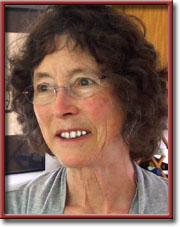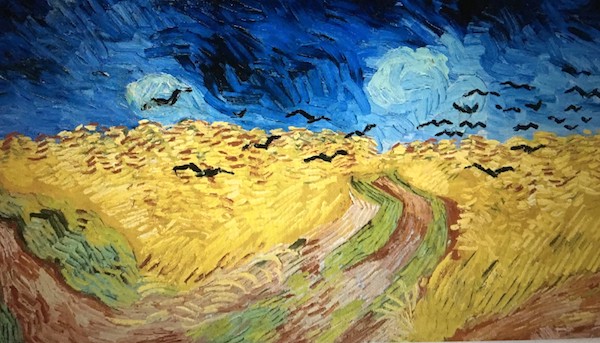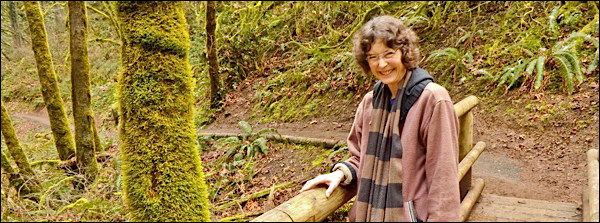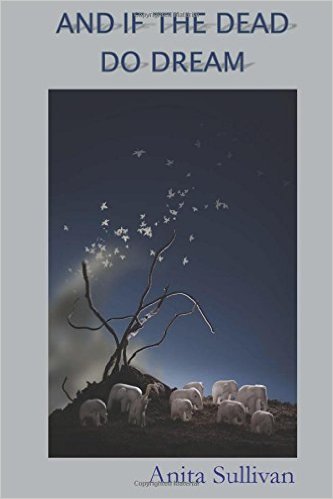How Do They Make Moons?
“A group of us were taking a walk at dusk near the city landfill, which was located on a spot from which you could get a pretty good view of the Sangre de Cristo Mountains. We lined up silently on top of a mound, looking across the uneven ground towards the dump itself, to await the full moon that was just rising into the limpid New Mexico heavens. After the enormous moon had freed itself from the uneven snags of the horizon, Timothy broke the silence and asked: ‘How do they make moons?’”—Anita Sullivan
On The Other Hand
By Anita Sullivan

 EUGENE Oregon—(Weekly Hubris)—June 2017—Most of us who have spent some time in the company of children will know about the subversive power contained in some of their urgent but innocent questions.
EUGENE Oregon—(Weekly Hubris)—June 2017—Most of us who have spent some time in the company of children will know about the subversive power contained in some of their urgent but innocent questions.
My own favorite example comes from a question my three-year-old son Timothy asked
39 years ago, when I was living in Santa Fe, New Mexico, a rare city that has managed to keep its deep magic alive and visible for those visitors and inhabitants who may be paying attention to such things.
A group of us were taking a walk at dusk near the city landfill, which was located on a spot from which you could get a pretty good view of the Sangre de Cristo Mountains. We lined up silently on top of a mound, looking across the uneven ground towards the dump itself, to await the full moon that was just rising into the limpid New Mexico heavens. After the enormous moon had freed itself from the uneven snags of the horizon, Timothy broke the silence and asked: “How do they make moons?”
I don’t know what we actually said to him. But later I wrote the following story as my response, hoping it did justice to the question. Most recently, when I sent this story to Tim (now age 42), he wrote back: “I remember wondering how moons were made. In fact I still wonder about that!”
![]()

How Moons Are Made
Timothy looked out the window one night and wondered.
“How do they make moons?”
Behind him, everybody tried to be helpful.
“There is only one moon,” they said.
“It is very old,” said his mother.
“It is 240,000 miles away,” declared his older sister, who was building a rocket.
“Made of rocks.”
“They have pictures,” said his father. “People have been to the moon.”
The Moon. The Moon.
After that, Timothy’s head felt round and full, like a small moon. He looked out the window again. But no, what he saw now was not the same moon as before. It was higher. It was smaller. And colder.
Timothy blinked. Who was making all these moons? How did they make them? And oh! he would like to be the best person of all, who went up in the big balloon full of moons every day and picked one out to set into the sky.
The next morning, Timothy put an orange into the pocket of his overalls and started out to find the Moon Factory. He walked along a dirt road winding through piñon pines and junipers. The day was warm and quiet, and Timothy listened and sniffed while he walked.
He saw a yellow acacia bush that seemed to have something stuffed into it. “Help, help!” said a small voice from inside the bush. Timothy rushed over. In between the twigs and blossoms he could see silky brown fur, dark expressive eyes.
“Too many Nobs!” it squeaked. “Somebody else will have to carry my secret for me!”
The little animal was shivering. The whole bush was shivering.
“I’ll carry your secret!” said Timothy.
“Close your eyes!” Timothy heard the animal wiggle out through the branches. He held out his hand, and something warm and smooth fell into it. When he opened his eyes, the creature had curled up into a ball, with its face poked down out of sight, ready to roll down the hill.
“Wait! What do I do with your secret?” Timothy cried.
“Take it to the Moon Factory,” said a muffled voice. “But watch out for the Nobs!”
And it was gone.
Timothy stood with his arm stuck out in front of him. Slowly, he opened his fingers. In the palm of his hand was a shiny yellow rock. Timothy felt prickly from the top of his head all the way down to his feet.
“Oh!” he cried. “A piece of Moon!”
A cloud came over the sun. Behind the pine trees Timothy heard quick sharp sounds like someone was tearing strips of paper. “What are Nobs?” he wondered.
He started walking very fast, holding the secret rock tightly in his hand. The orange bumped in his pocket, reminding him how thirsty he was.
Just in front of Timothy was a small green and white sign. The letters said S A N I T A R Y L A N D F I L L with an arrow pointing up. “Maybe that means a place where they have factories,” Timothy thought.
The road ended suddenly at the edge of a ditch. Timothy peeked over and saw piles of junk at the bottom, old refrigerators and sofas, heaps of tires. A big yellow bulldozer was down there too, its nose buried in a wall of dirt.
Behind him, Timothy could hear soft thuds and quiet hisses. He started to run like a mouse, along the top of the ditch.
Suddenly, his feet went right out from under him. Down, down he tumbled into the large cavity, rolling over in the dirt at the bottom, still clutching the moon rock. Way up above him he heard the tearing sound again, “Rip! Rip! Rip!” He looked up and saw a row of shiny metallic faces shaped like triangles, with tiny round eyes and mouths.
“There he is!”
They clanked their heads together and hissed; then they started hopping and sliding quickly over the side, towards him. These must be Nobs, he thought.
Timothy shivered. There was no place to run. Taking a deep breath, he wrinkled up his nose and stuck out his tongue.
“Nyahh! Nyahh!” he shouted.
To his surprise, the words roared and clanged in the air like train cars being coupled in a train yard. It was a loud metal language the Nobs understood. All together they clawed their way back up the side of the ditch, banging their heads together again. Then they turned and disappeared, leaving a little swirl of dust behind.
Timothy felt weak. He reached into his pocket for the orange, but it was gone. Then he looked around to find a way out. The other side of the ditch was very steep, but there in the wall about halfway up he saw a small wooden door with a handle. Beside the door a sign hung from a yellow post. It said “Moon Factory.”
When Timothy touched the handle, the door flew open. Inside was a wide tunnel with a soft glow down at the end, like moonlight. As he walked slowly through the tunnel, Timothy heard thumping and rumbling noises, and then some voices.
“Too much string. Always too much string. Where did Peter go with the scissors?”
“What moon is it tonight, Phoebe?”
“Gibbous, waning.”
“Oh, dreadful dreadfuls! We’re not ready! Where are the Luppels? Have they all been eaten by the Nobs?”
“Peter, bring me the scissors, there’s a good chap, will you?”
“I’m busy. Tear it with your fingers.”
“WHAT HAS HAPPENED TO OUR GOOD FAITHFUL LUPPELS?”
Timothy stood at the door of a huge cave filled with splashes and pools of warm yellow light. In the cave were seven huge tubs with seven tall stools, and on these stools stood seven small people in overalls just like his, holding long silver spoons which they kept poking into the tubs. From the ends of the spoons dripped something thick and golden, like pancake syrup. The seven little people were singing and talking constantly at the top of their voices.
Directly in front of Timothy, a plump little lady in a yellow and blue checked apron was winding up a mound of string. The string was spilling out onto her shoes, completely covering them. A badge on her apron said “Phoebe.”
“Oh, a boy!” she said when she saw Timothy. “We don’t usually get boys.”
“Please,” said Timothy politely. “I have a moon rock.”
“Only one?”
Timothy gulped. He held out his hand and opened it slowly. The small rock began to glow. Timothy felt happy.
“Just drop it in there,” Phoebe pointed to a pail. “You didn’t happen to see any Luppels along your way, now did you?”
“What’s a Luppel?” Timothy asked. But he thought he knew.
“Oh, small, furry, large eyes, long paws.”
Just as he thought. A Luppel had given him the moon rock. “Just one,” he nodded. “But there are lots of Nobs out there today.” He put his rock slowly into the pail.
A fat little man with a spoon behind his ear hurried out from behind one of the tubs.
“Did you hear that, Peter?” Phoebe said. “Nobs are on the rise again. Eating all our good Luppels. What can we do?”
“Send out the crows, drat it!” Peter pulled his spoon down from his ear. “Here, boy, can you stay and stir for awhile?”
Peter grabbed a piece of string from his pocket and started to scribble on it with his spoon. “Drat!” Where’s a pencil!”
“How did you get past the Nobs, did they chase you?” asked Phoebe.
Timothy explained.
Her eyes grew big. “Oh my! Did you hear that, Peter?”
But the portly man was still writing. “Our yellow extractor is down again, and I’m expected to get a Gibbous moon out in less than five hours?” He tore at the fringe of hair around his bald head. “And the Nobs on the rise again!”
Phoebe whispered into his ear. Peter looked up.
“What did you say to them, my boy?”
“I only said ‘Nyahh! Nyahh!’” Timothy repeated.
Peter scribbled furiously. “How do you spell that?”
Suddenly Peter leaned back his head and gave a piercing whistle. With a swish of wings a crow flew down from high in the back of the cave. He wore a yellow patch over one eye.
“Gittelish Granadu Mvr Rannel Pzeritch!” said Peter to the bird. “Nyahh! Nyahh!”
“Nyahh! Nyahh!” croaked the bird. Timothy giggled. With a little piff! the crow flew down the tunnel towards the front door.
Peter stood with his hands on where his hips should have been, and looked back at the seven tubs. “Now, how to get out a Gibbous moon with no yellow extractor.”
Timothy cleared his throat. “You mean, you make a new moon every day?”
Peter bustled away behind a moon tub. “Well, it’s the same and it’s different, at the same time, if you see what I mean,” he said. “The sum is greater than the whole of its parts, or whatever they say.”
“It’s a sort of re-cycled moon,” explained Phoebe. “The moon comes apart after it’s full, you know. Dries out and cracks and falls to Earth in a million pieces. That’s why the sky is dark for a few days each month. Those are our busiest times. We have teams of Luppels out there, picking up the pieces.”
“But we never get them all, not ever all,” Peter added with a sigh. “The yellow extractor is meant to fill in the gaps.”
Phoebe whispered behind her hand. “The moon is the yellowest, the very YELLOWEST thing of all, so it takes a lot to fill it up. In a pinch, we can mix green and red, there’s plenty of that around. But it’s really easier, what with all the daisies and rabbit brush and school buses. . . .”
She broke off at a little scurrying sound from the tunnel. Behind Timothy came a line of Luppels, each carrying a mouthful of moon rocks.
“Welcome!” cried Phoebe. “What are the Nobs like today?”
“Clank! Clank! Shine! Shine! Tear! Tear!” chittered the Luppels, their eyes large and sorrowful.
“Today ‘Clank,’ yesterday ‘Miaow’, tomorrow ‘Roar’!” said Peter. He tore his hair again, just a little. “Never the same from one day to the next!” Then he pointed with his spoon to Timothy.
“This boy here, he has brought us a good way to scare them.”
Timothy felt proud.
Phoebe took a little group of Luppels over into the corner and Timothy heard a little chorus of growly voices saying “Nyahh! Nyahh!”
It was time to leave. Everyone was busy and he was in the way.
“Hey, boy!” Peter came up, puffing and steaming. He bowed.
“Thanks to you, the moon will rise on time tonight!”
“The moon will rise on time tonight!” echoed voices from around the cave.
“The balloon will be going up in about four hours. Wish we could show you everything, but you know, certain secrets. . . .” Peter pushed his spoon around back of his head so he looked like a creature with really long ears.
Timothy said good-bye and walked down the tunnel in a happy daze. Behind him, the Moon Factory thumped and rumbled.
Back in the sunshine, he climbed up the side of the ditch and hurried towards the road. It was late afternoon. Timothy thought about the time when night would come, and the big yellow moon would slide up from behind the mountains. A small piece of that moon he knew he had held for a short time as a secret inside his own hand.
![]()
To order Anita Sullivan’s books, Ever After and/or And if the Dead Do Dream, click on the book covers below.



One Comment
Lisa Norris
Delightful story!